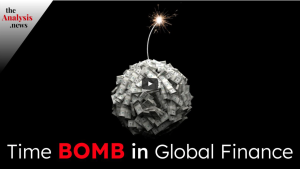That’s what the world is finding out right now. Since the 2008 financial crisis the countries that sit atop the world economy – the United States, China, and Germany – have failed to cooperate and fix a broken system that is creating unnecessary suffering.
At the heart of our global economic problems is a failure to lead by the world’s most important countries and the absence of an international regulatory framework with the power to encourage them to do so.
For the latter part of the 20th century, we lived in an economic world orchestrated by the Washington consensus. While this system had many losers and fed and subsidized financial institution profits, it also provided a semblance of order for the global economy. But for many, the 2008 crisis signaled that the long period of U.S. hegemonic leadership was coming to a sputtering end.
The U.S. consumer is tapped out in the aftermath of the credit crisis. Yet the export-heavy growth strategies of the world’s next two largest economies have left them with consumer classes that are unwilling or unable to fill the gap left in the wake of collapsing wealth in the U.S.
The necessary rebalancing in this situation has long been clear: the expansion of domestic demand in the export surplus countries, particularly Germany and China. But none of their political economies have been able to overcome internal opposition to this transition.
In Germany, there remains fierce domestic resistance to providing necessary assistance to the euro zone periphery, even though the euro countries that are now suffering got into their current mess in part because of overzealous lending practices by many German banks. The Germany that so recently benefited from the euro zone’s collective largesse is now crying moral hazard when asked to step in and help their neighbors adjust like Germany did with the help of the Southern countries vitality after reunification.
Meanwhile, China, following the example of Japan and the Asian tigers before it, has built its vitality on the back of exports to the West. Most pointedly, China has exploited a flaw in the international monetary system to its benefit. China unilaterally sets the exchange rate between the renminbi and the U.S. dollar to benefit its manufacturing exports. The practical result is that RMB undervaluation is exporting deflationary pressure to the developed world.
The contradiction in this system is that in the long term China depends on consumers in the developed world countries to continue buying Chinese exports while China’s economic competitiveness is deflating the incomes of precisely those same consumers. This is the wall that the global economy hit in 2008 when the credit bubble in the U.S. collapsed.
As the current worldwide economic downturn shows, this paradox is a significant problem. China is not a tiny vessel being towed along by the global economy; it has become an enormous anchor that is sinking the global economic ship. Only rising wages and living standards for Chinese citizens can power the world’s economies into the future and take stress off of the developed countries as they rebalance.
It’s important to remember the historical context that gave rise to China’s economic strategy. China’s growth model is in many ways a response to the 1997 Asian crisis, when the developed world – led by the U.S. – used institutions like the International Monetary Fund to squeeze Asian countries, causing them unnecessary pain so Western financiers could get paid.
This is where America has failed. After the Cold War, the U.S. had the opportunity to lead the world into a truly stable global economic system. But no longer facing the looming threat of Communism, the U.S. instead turned the world into a plaything for financiers and multinational corporations in search of lower labor costs and lax environmental restrictions. American financial elites sowed the seeds of their own system’s destruction.
And now the damaging effects of the elite class’s predations have arrived at home. The unsustainability of the Reagan- and Clinton-era economic models of continuous financial deregulation, pumping wealth upward, and subsidizing foreign direct investment in low-wage developing countries, has become obvious. The current system is simply not sustainable for the U.S. and, as a result, for the exporters who depend upon a vital American consumer, particularly China and Germany.
Of course, changing to domestic-led demand-based growth strategies will take time and will have to overcome fierce political resistance from both American multinationals addicted to artificially low-cost climates and China’s and Germany’s overgrown export sectors.
But the reality is that continuing along this path is not in China’s interests, regardless of how reluctant its leaders are to relinquish their model of success. The same can be said for Germany, which must adjust its economic strategy to save the euro zone or it will sink along with it.
It is important to recognize that many of these problems are not just domestic malfunctions. Rather they are symptoms of a chaotic and incoherent international financial system. And it is by no means certain that China or anyone else will emerge as a new leader of a cohesive global economy.
This uncertainty is making the world an increasingly dangerous place. It’s why the Institute for New Economic Thinking’s upcoming conference in Hong Kong is called “The Changing of the Guard?” Because it’s unclear who is going to lead the way forward.
The price of the current disorder is simply too ominous to endure. There is a way. We must find out if there is a will.






